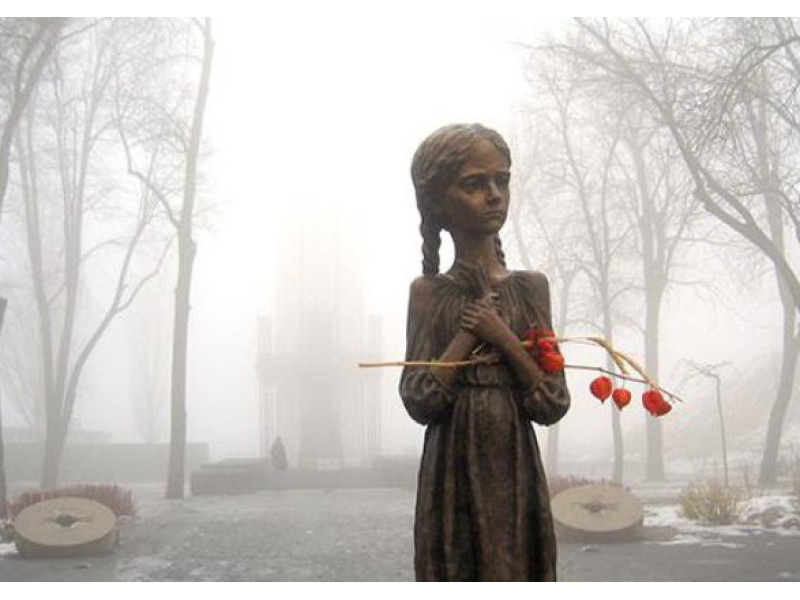There are Dates that do not bring joy or elation, Dates that exude sadness, longing and pain, Dates that make you think and reevaluate yourself and your outlook on life and attitude towards it. On the fourth Saturday of November (this year it is November 25), we honor the memory of the victims of the Holodomor of 1932–1933: both those who died during this genocide and those who simply miraculously survived this horror. On this day, a number of solemn events will take place in many cities of Ukraine: laying flowers at memorial signs, memorial prayers in churches of different denominations, at 4:00 p.m. a national minute of silence will be announced, after which the "Light a Candle" action will be held, during which all those who wish will carry candles to places of honor (you can also simply light a candle on your own windowsill - and thus honor their memory). We have prepared a selection of books and films about the Holodomor for this date.
Books about famine. Fiction

Vasyl Barka. "The Yellow Prince"
The novel is based on the author's memories of the Holodomor of 1932–1933 (his brother and his family survived these terrible times) and the testimonies of eyewitnesses to the Holodomor, which Vasyl Barka collected for about 25 years. The main characters of the novel are the members of the Katrannyk family, of whom only the youngest, Andriyko, was able to survive the famine (for that time this was a typical situation, one or two remained from large families). According to Vasyl Barka, his "Yellow Prince" is "the story of one family in 1932–1933; one white house that turned black and turned into a coffin. Its fate is depicted against the background of the life, or rather, the death, of all of Ukraine during the famine."

Ulas Samchuk. "Maria"
The main character of the novel, Maria, is a typical woman of her time, who worked on and near the land all her life. The novel begins with a countdown of the days of Maria's life, "if you don't count the last three, Maria met and spent twenty-six thousand two hundred and fifty-eight days." This book, without embellishment, showed both the Holodomor, and the "beautiful voluntary" collectivization, and the forced grain collection. Samchuk dedicated his novel to the mothers "who died of hunger in Ukraine in 1932–1933."

Oleksandr Motyl. "Sweet Snow"
This novel by a Ukrainian American (or an American Ukrainian) is about the events of the winter of 1933, when former prisoner-spies become witnesses to the Ukrainian famine. A German aristocrat, a Jewish communist, a Polish diplomat, and a Ukrainian nationalist pass by deserted villages and frozen bodies. They are forced to fight for survival, hiding from both death and their pursuers.
Books about famine. Documentary publications

José Eduardo Franco, Beata Cieżyńska. “The Holodomor (1932–1933) — an Unknown Ukrainian Tragedy”
This collection contains articles by historians, sociologists and political scientists who have investigated the background to the Holodomor and its consequences, and also presents a legal assessment of the Holodomor as a phenomenon of genocide against the Ukrainian people. The collection also includes mentions of the Holodomor in the Portuguese press and the activities of the local community in the memory and recognition of the Holodomor in Portuguese culture. It also includes a list of acts on the Holodomor issued by international organizations, national parliaments, political and religious leaders, state and municipal regional assemblies, and the academic community.

Alain Besançon. "The Evil Century. On Communism, Nazism, and the Uniqueness of the Holocaust"
The author showed the two most brutal political regimes of the 20th century — Nazi Germany and the communist USSR, which killed millions of people. He proved the similarity of the methods of communism and Nazism. In addition, Besançon examined the issue of the Holodomor. In his opinion, the purpose of the Holodomor was not to break the resistance of the peasantry to collectivization, but to put an end to the existence of the Ukrainian people.

"National Book of Remembrance of the Victims of the Holodomor of 1932-1933 in Ukraine"
This is one of the most thorough studies of the Holodomor. The Book of Memory consists of a national and 18 regional volumes prepared in the regions affected by the Holodomor. The Book analyzes the historical and legal aspects of the Holodomor, collects eyewitness accounts and documents of the time that prove the fact of the genocide. It also contains about 140 photographs from that time (which are simply terrifying).

"33rd: Famine: People's Memorial Book"
It contains testimonies of people who survived the Holodomor. The editors have collected and published about 6,000 testimonies about genocide and other atrocities. According to one of the editors, Volodymyr Manyak, "this publication is both a cemetery of memory, a memorial, and an encyclopedia of grief and sorrow. The tragedy of the people, confessed by the voice of martyrs. A book of national memory, where people consult, weigh, testify, where the truth of history is reflected in thousands of human destinies."

Stanislav Kulchytskyi. “The Holodomor of 1932–1933 as a Genocide: Difficulties of Awareness”
Having analyzed numerous documents and testimonies, the author proves that the Holodomor of 1932–1933 was the result of a punitive action to seize all the food available from the peasants. The book documents that Stalin deliberately used this terrorist action in a situation of acute crisis and famine in many regions of the USSR.

Vasyl Marochko, Olga Movchan. "The Holodomor of 1932–1933 in Ukraine. Chronicle"
A chronicle-documentary publication that reproduces facts, events, and phenomena in the villages of the Ukrainian SSR in 1932–1933 – the Holodomor, caused by complete collectivization, excessive grain procurement, and repressions. The book is based on published collections of documents and materials, archival funds of Ukraine and Russia, correspondence and secret ciphers of Stalin, letters from peasants to the party and Soviet nomenclature, and reports by foreign diplomats.

Ruslan Pyrig. "The Holodomor of 1932–1933 in Ukraine. Documents and Materials"
The book contains a set of documents and materials that reveal the causes, course, scale and consequences of the Holodomor. It contains documents of the Politburo of the Central Committee of the All-Union Communist Party (Bolsheviks) and the Politburo of the Central Committee of the Communist Party of Ukraine (Bolsheviks), the Council of People's Commissars of the USSR and the Council of People's Commissars of the Ukrainian SSR, local party and Soviet bodies, institutions of the State Prosecutor's Office, the court, the prosecutor's office, the police; correspondence of Stalin, Kaganovich, Molotov, Kosior, Chubar and others; numerous appeals of peasants - letters, statements, complaints, requests; unique diary entries of eyewitnesses to the famine; materials of foreign diplomatic representatives, organizations of the Ukrainian emigration, and the international community.

"Resistance to Genocide. Exhibition Catalog Book"
This book is a catalog of the photo-documentary exhibition "Resistance to Genocide", created for the 81st anniversary of the Holodomor by the Ukrainian Institute of National Remembrance together with the Branch State Archive of the SBU, the Center for Studies of the Liberation Movement, and the Public Committee for Commemorating the Victims of the Holodomor-Genocide of 1932–1933 in Ukraine.

"Holodomor, the genocide of the Ukrainian people of 1932–1933"
This brochure briefly describes the main causes of the most terrible tragedy in terms of scale and course of events that the Ukrainian people experienced in 1932–1933. The authors reveal the background of the tragedy, emphasize its artificiality. They argue that the creators of the Holodomor were the top leadership of the Communist Party led by Stalin. The author's focus is on finding an answer to the question of why terror through famine was directed against Ukraine. The brochure describes the mechanism of the Holodomor, its malicious intent, and qualifies it in accordance with the 1948 UN Convention as genocide, a crime against humanity.
Holodomor in films
"Unknown Hunger" (1983)
The documentary film about the Holodomor "The Unknown Holocaust". Ukraine 1933. 10 million victims" (The Unknown Holocaust), filmed in 1983 by Canadian filmmaker Taras Hukal in Quebec, Montreal. The film is based on interviews with eyewitnesses and researchers of the Holodomor, in particular, an interview with the famous Harvard University scholar James Mace is shown. This little-known documentary was the first film about the Holodomor in Ukraine.
"Hunger-33" (1991)
The film is based on the story of Vasyl Barka. It reveals the crimes of the Stalinist-Bolshevik regime against the Ukrainian people - the artificial famine of 1932-1933. Western countries knew little about this Holodomor. Soviet official bodies denied the fact of the famine. The terror of the winter-spring of 1933 was caused by the forcible confiscation of food and livestock from peasants. Then, a peasant family found itself at the center of this tragedy.
"The Hour of Darkness" (2003)
The film is dedicated to the events of the Holodomor of 1932–1933 in Ukraine. The film consists of documented archival photo and video materials, and eyewitness accounts of the Holodomor of 1932–1933.
"Holodomor. Ukraine, 20th Century: Technology of Genocide" (2005–2007)
A documentary film trilogy dedicated to the Holodomor in Ukraine in 1932-1933. The film tells about the terrible genocide of the Ukrainian people in the 20th century, provides comments from witnesses of the genocide and their descendants. The film is based on archival materials, in particular, from the Pshenichny State Film, Photo and Phono Archive.
"The Spell of Forgetfulness. The Holodomor of 1932–33 in Luhansk Oblast" (2009)
A documentary-journalistic film, which became a kind of summary of many years of research work on the issues of the Holodomor of the 1930s, the collection and analysis of materials, in particular, documents from the Branch State Archive of the SBU, as well as video recordings of the testimonies of hundreds of eyewitnesses of the Holodomor in Luhansk region, born from 1908 to 1923. These shocking confessions became the basis of the plot of the film. When asked what was more terrible for them - the famine or the war, some of the eyewitnesses answered: famine: “During the war, there was hope for “ours” who would return, but during the famine, there were no “ours.”
"Holodomor. The Forgotten Genocide" (2014)
A French documentary about the genocide of the Ukrainian people, the Holodomor. It is based on archival documents, comments from experts from Ukraine and France, and testimonies from numerous eyewitnesses. The director noted that she dedicated the film “Holodomor. The Forgotten Genocide” to all those who survived the terrible famine. “I decided to make the film after talking to a Ukrainian family whose parents survived the great famine. To gather more information about the tragedy, I traveled to Poltava and the Kyiv villages of Tarhany and Sobolivka, and looked for documents in the Vinnytsia archive. However, I gathered most of the material from eyewitnesses.”
"Bitter Harvest" (2015, shown in Ukraine in 2017)
At the center of the picture is Yuri, a talented peasant artist, a descendant of a Cossack family, who tries to live with his beloved in the conditions created by the Soviet authorities, accepting blows and oppression. But, in the end, when his family and fellow countrymen become victims of artificial famine and Stalinist repressions, he rises up to save his relatives, take revenge and leave Soviet Ukraine to tell the world the truth about the horrors of the Holodomor.
This is only a small part of what has been written and filmed about the Holodomor.


Write a comment